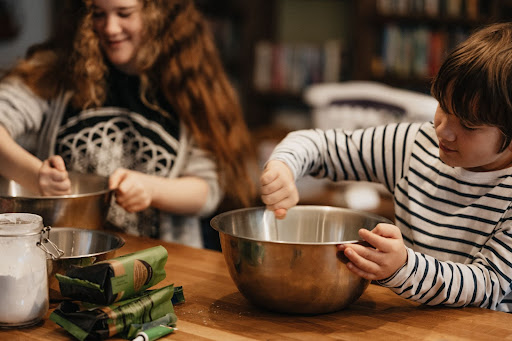Cooking as a family can be a fantastic way to bond, create lasting memories, and develop essential life skills. Not only does it bring everyone together, but it also encourages teamwork, creativity, and healthy eating habits. Whether you’re a seasoned chef or just starting in the kitchen, involving your family in cooking can be educational and enjoyable. This guide explores valuable tips to help you make the most of your family cooking adventures.
From meal planning to kitchen safety, exploring new recipes, and embracing creativity, these tips will help you create a fun and enriching cooking experience for the whole family. So gather your loved ones, put on your aprons, and embark on a culinary journey filled with delicious food, shared laughter, and cherished moments!
- Plan meals together: Involve your family members in meal planning. Discuss what everyone likes and try to incorporate their preferences into the menu. It encourages participation and ensures everyone enjoys the meals.
- Allocate tasks: Assign age-appropriate tasks to each family member to get everyone involved in cooking. Younger children can help wash vegetables or set the table, while older kids can assist with chopping, stirring, or measuring ingredients.
- Create a safe cooking environment: Ensure your kitchen is safe for everyone. Teach children about kitchen safety rules, such as cautiously handling knives and hot surfaces. Supervise them closely when they’re near heat or using kitchen appliances.
- Teach basic cooking skills: Cooking together is an excellent opportunity to teach your children basic cooking skills. Show them how to correctly measure ingredients, chop vegetables, and use kitchen tools. It helps them develop independence and confidence in the kitchen.
- Try new recipes: Encourage your family to explore recipes and cuisines together. Choose dishes that are simple and involve different flavors and textures. It expands everyone’s culinary horizons and makes cooking more exciting.
- Incorporate nutritious ingredients: As you cook with your family, focus on nourishing ingredients. Opt for fresh fruits, vegetables, lean proteins, whole grains, various foods with arginine, and healthy fats. Experiment with different colors, flavors, and textures to make your dishes visually appealing and deliciously nutritious.
- Make it a learning experience: Cooking offers numerous learning opportunities. Teach your children about different ingredients, their nutritional values, and how to make healthy food choices. Explain cooking techniques and their science, such as why baking soda makes dough rise.
- Embrace creativity: Cooking is an art, so encourage your family to get creative. Experiment with ingredient substitutions, spices, and flavors. Allow everyone to add their personal touch to the dishes. It fosters innovation and makes cooking more enjoyable.
- Enjoy mealtime together: Make an effort to have regular family meals where everyone can sit together and enjoy their prepared food. Use this time to reconnect, share stories, and appreciate the effort put into the meal.
- Encourage taste testing: Get your family members involved in taste testing and providing feedback on dishes. Allow everyone a say in flavors, seasoning adjustments, and overall taste. It helps develop their palate, encourages constructive communication, and empowers them to express their preferences.
- Document family recipes: Preserve family traditions and recipes by creating a family recipe book or journal. Encourage each family member to contribute their favorite recipes and personal stories or associated memories. It becomes a cherished keepsake that can be passed down through generations, fostering a sense of culinary heritage and family connection.
- Emphasize kitchen cleanliness: Teach your family the importance of maintaining a clean and organized kitchen. Encourage proper handwashing before and during food preparation, clean countertops and utensils, and promptly store leftovers. A clean and hygienic kitchen ensures food safety and sets a good example for your family’s well-being.
- Create theme nights: Make mealtime exciting by implementing theme nights. Choose a specific cuisine or a fun theme like “Taco Tuesday” or “Pizza Party Friday.” Get everyone involved in selecting recipes, decorating the table, and even dressing up according to the theme. It adds an element of creativity and anticipation to your family meals.
- Keep it fun and flexible: Family cooking should be a joyful experience. Embrace spontaneity, laughter, and the occasional kitchen mishap. Allow room for creativity, adapt recipes to suit your family’s preferences, and don’t be afraid to try new things. The most important thing is to enjoy the process and savor the time spent together in the kitchen.
In conclusion, cooking as a family is a fantastic way to foster togetherness, enhance culinary skills, and create cherished memories. By involving everyone in the meal planning and preparation process, you can instill a love for food, promote healthy eating habits, and develop essential life skills in your family members. Through teamwork, communication, and creativity, you can transform your time in the kitchen into a fun and educational experience for all. So, whether you’re cooking up a family favorite or venturing into new culinary territories, embrace the joy of cooking together and savor the delicious rewards that come with it. Happy cooking and bon appétit!
I believe in the power of words and I think God has blessed me with the same. I have a strong experience in the area of writing and love to share my work with the readers. Happy reading!!







